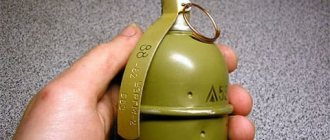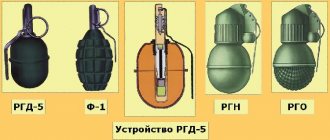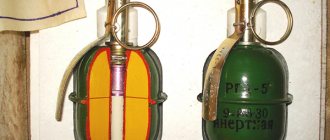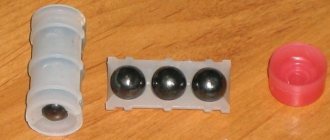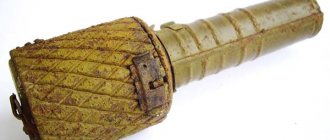A short excursion into history
In the 9th century, the prototype of hand grenades were clay vessels with incendiary mixture or lime. The first garnets were primarily made from clay. In the 15th century, Konrad Kaiser von Eichstadt first proposed making a grenade body from cast iron, and also leaving a cavity in the center of the powder charge. This cavity was supposed to speed up the combustion process of the mixture and increase the likelihood of crushing the body into fragments. Kaiser grenades were used in the defense of fortresses. Conrad's hand grenade was ignited from a fuse in a wooden plug, which in turn plugged the seed hole. Such a grenade could not be considered reliable. Often the explosion occurred either too early or too late; the device clearly needed improvement.
In connection with the advent and development of hand grenades, such a military specialty as the grenadier appeared. A grenadier is an infantryman specially trained to throw grenades. The first professional hand grenade throwers appeared in the 17th century in France. The strongest and tallest recruits were selected to become grenadiers. However, over the years, battle tactics have changed. Priorities in field battles were now given to handguns and artillery. In many armies, grenadier regiments were preserved, however, their role as grenade launchers was forgotten.
Interest in hand grenades was renewed during the Russo-Japanese War (1904-1905). They already widely used high explosives based on ammonium nitrate and Nobel detonators. Some grenades had grating or spring fuses, most had Bickford powder fuses.
The First World War (1914-1918) was protracted. Often the forward trenches were several tens of meters apart. In these conditions it was very convenient to use hand grenades. Their development by gunsmiths from Germany, England and France was kept secret. In 1913, the German military industry began producing the Kugelhandgranate 13 grenade. These grenades had a large and awkward body, an unreliable fuse and a weak fragmentation effect. In 1915, the Englishman Mills created the “Grenade No. 5”. Around the same time, the French invented the world famous lemon juice.
In Russia in 1909, artillery captain Vladimir Iosifovich Rdultovsky developed a “1912 model” grenade. It officially entered service with the Russian army. In 1914, Vladimir Iosifovich changed the shape of the grenade body, improving the fragmentation effect. By the summer of 1916, the production of grenades was established and amounted to 3.5 million per month. During the First World War, mainly high-explosive fragmentation grenades were developed and improved. Around the same time, there was a division of grenades into defensive and offensive.
In 1933, the RGD-33 offensive-defensive grenade appeared in the USSR. However, it turned out to be expensive to produce and inconvenient in practice. In 1942, the RGD-33 was replaced by the RG-42, designed by Korshunov. The small selection of domestic grenades was explained by the fact that the Soviet command at that time considered the development of small arms and armored vehicles to be the highest priority. Pomegranates have been known to mankind for quite a long time. The Chinese dabbled in similar weapons, miraculously sawing each other out for many centuries. However, in Europe they became widely used earlier. The first cases of grenade use date back to the English Civil War. After this, these weapons and a special type of infantry - grenadiers - began to be widely used on the battlefields of Europe, and in Russia they were introduced by Peter the Great. It is the need to throw grenades that explains the headdress of the grenadier (so different from the musketeers in their cocked hats), the cone-shaped grenadier hat (first a soft cap, and then a hard one, with a brass forehead). It is interesting that the only regiment that carried grenadier caps (first as an element of field uniform, and later as part of a dress uniform) before the collapse of the Empire was the Pavlovsk Grenadier Regiment, which received the highest permission for this distinction for bravery in the battles of 1806-1807, and later, for the battles of 1812-1813, and the rights of the Young Guard (as well as the right to march in a ceremonial march with guns “on hand”).
Description of design
In the RGO model, the grenade looks very significantly different from its direct predecessor F-1. The body of the grenade has a more rounded shape, the usual protruding fuse tube is missing, and the notches on the RGO body are much smaller than those of the F-1. The body of the RGO grenade consists of four hemispheres (two internal and two external), which are made of steel 2.8 mm thick. Each of them has internal notches, and the lower outer hemisphere has external corrugation, which distinguishes this grenade from the RGN and allows the fighter to determine by touch the type of grenade used.
At the top of the grenade there is a thin-walled glass with a large thread (M20x2) rolled for screwing the fuse into it. During transportation and storage of grenades, a stopper is inserted or screwed into the glass to avoid contamination of the glass. Unlike previous generations of grenades, the new ammunition uses a more powerful explosive charge consisting of hexogen and TNT.
The main feature of the design of the RGO (as well as the RGN) is the more complex UDZ fuse, based on the principle of combined impact-remote action.
The very first
Perhaps the term “pomegranate” means “fruit” and comes from the name of a famous fruit. According to other sources, this word was formed on behalf of the Spanish city of Grenada, and the soldier-grenade throwers began to be called grenadiers accordingly. It is not known exactly when the very first explosive grenades appeared. But already in 1274, during their landing in Japan, the Mongols of Kublai Khan used exploding shells, with the help of which they frightened the horses of the samurai and brought panic into their ranks. The famous English historian David Nicol in his fundamental study “Weapons and armor of the Crusades. 1050-1350" reports that throughout the Muslim East, so-called grenades are found, which look like small ceramic vessels in the shape of a heart with a hole in the top. They date back to the 13th-15th centuries, and traces of mercury fulminate, a fairly powerful explosive, were found on their walls. So it is quite possible that these were real grenades, which were thrown either by hand or with the help of a belt sling into the ranks of the enemy! In Korea, the first metal grenades appeared at the end of the 16th century, they began to be used in the fight against the Japanese invasion, and in medieval India, grenades made from bamboo cylinders filled with gunpowder were used even earlier, during the wars of Sultan Akbar. Banns were thrown at the feet of war elephants so that they would get scared and turn back. In Europe, hand grenades, which looked like metal balls, were cast from cast iron and weighed about two pounds (800 grams). Such grenades became widespread at the end of the 17th century, and during the 18th century they were used very widely. They were thrown again with their hands or with the help of hand-held mortar-grenade launchers, which were an ordinary gun with a flintlock and a short barrel into which a grenade was inserted from the muzzle.
Device
Offensive grenades have a body made of steel.
To prevent it from rusting in combat conditions, grenade bodies are coated with special protective substances. However, the steel case does not produce a significant fragmentation effect. To create a large number of fragments, a steel tape is placed inside the RG-42 body, rolled into a roll and tightly adjacent to the machines. When an explosion occurs, the tape breaks into a large number of fragments, creating a compact but dense affected area. In addition to cast iron and steel, grenade bodies are made of impact-resistant ceramics, plastic, cardboard and hard rubber with semi-finished fragments pressed into it. Combat charge
Explosives are chemical compounds or mixtures thereof that are capable of exploding as a result of any internal processes or external influences. During this process, they release highly heated gases and generate heat. During an explosion, explosive decomposition occurs literally in hundredths of a second. Hot gases formed as a result of a chemical reaction sharply increase in volume and are the main factor in the destructive effect of the explosion. There are many explosive things and mixtures. They differ in different sensitivity to heat, heat and friction.
Fuse
The fuse is needed in order to ensure a reliable detonation after the throw and to prevent the grenade from being detonated without permission. There are two types of grenade fuses based on their action: remote and impact. Remote fuses provide a temporary delay in the explosion, and impact fuses detonate the grenade when it hits the surface with a certain force. The main advantage of a remote salvo is the reliability of the action, the disadvantage is that it is impossible to ensure an instant detonation of a grenade when it touches the target.
Traditionally, there are three main types of igniters: grating, impact and spring. The principle of operation of a grating igniter is similar to a New Year's cracker. A strong, rough thread is pressed into the friction-sensitive pyrotechnic composition. When pulled sharply, it creates the friction necessary for ignition. To activate the impact igniter, the protruding rod of the firing pin must be struck against any sufficiently hard surface, and then the grenade is thrown as quickly as possible. A serious disadvantage of such an igniter is the fact that in the field it is not always possible to find a sufficiently hard surface. The spring igniter is an impact igniter without the disadvantages. An experienced officer can reinsert a pulled pin or hold the firing pin spring with his finger to prevent an explosion.

